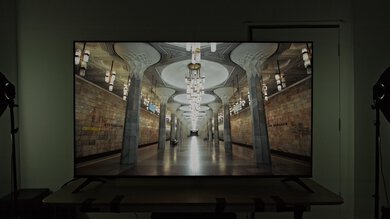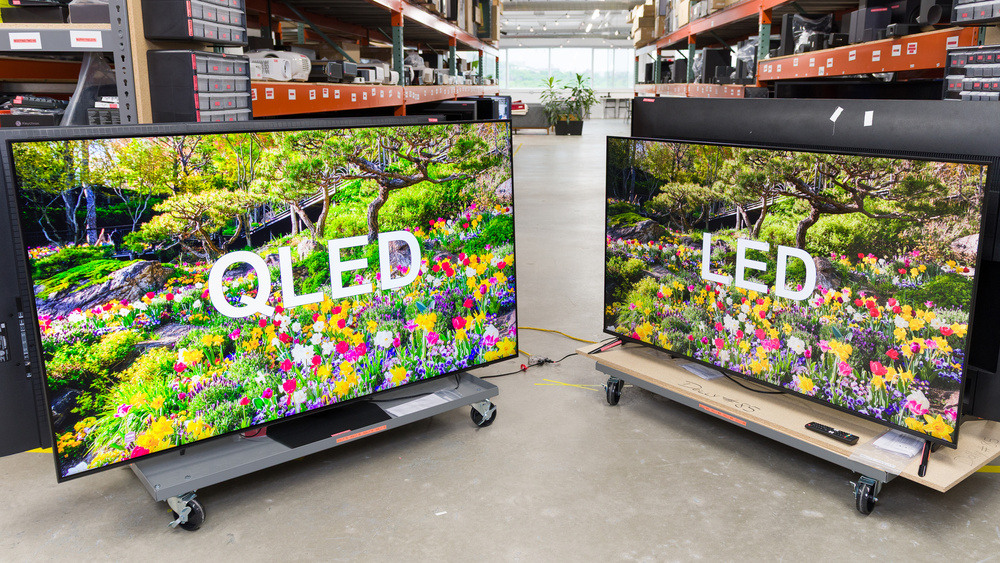
In the battle of TV display technologies, QLED vs LED used to be a tough decision. Up until a few years ago, LED TVs were the latest craze. Thinner and brighter than the Plasma TVs they replaced, LED was the TV to buy. That changed a few years ago with the introduction of Quantum Dots, or QLEDs. This new technology promises much better, lifelike colors than ever before. Now, a little spoiler: QLEDs are generally much better than simple LEDs, but what do these terms actually mean, and how do they impact your viewing experience? To learn more about these and other types of TV panels, check out our guide on TV panel types.
What Are They?
Before we get into the details of how they perform and how you should choose one, let's start with the basics. This part is a bit technical, so if you just want to see if QLED is better than LED, skip to the performance section below.
QLED
QLED, or Quantum Dot Light Emitting Diode, is mainly a marketing term to describe various panel technologies that use an LED backlight, but with the addition of quantum dots. Quantum dots are a better way to produce color in TVs that use LEDs as a backlight. Before QLED came along, most LED TVs used white LEDs to produce light. This light then passes through three color filters to produce the separate red, green, and blue subpixels. This process is very inefficient, though, as it works by simply blocking the unwanted portions of light coming from the backlight.
Quantum dots, on the other hand, are extremely efficient at converting light. Instead of stripping away every unwanted color from a white light source, quantum dots work by taking the energy from light that hits them and emitting new light at a different wavelength. This process is far more efficient at producing light, as it takes most of the energy from the light coming in and directly converts it to the desired wavelength. That's not all, though. The wavelength of the light emitted by a quantum dot depends only on the size of the dot. Since manufacturers can precisely and consistently control the exact size of the dot, they can produce a much purer color spectrum. This allows for a wider color gamut, with brighter, more vibrant colors.
Not all QLEDs are created equally, though. Most of them produce blue light at the source, and then use quantum dots to convert that into red and green light. Lower and mid-range models often use a simpler type of quantum dot to produce green light and a KSF phosphor to produce red instead of using quantum dots. For most of this comparison, it doesn't really matter, and we'll lump QLED and KSF models together. In some cases, though, we'll separate the KSF panels so you can see how they compare to the full QLED experience. Learn more about QLED.
LED
What is LED? LED stands for Light Emitting Diode, and as the name suggests, it's a way to produce light. LEDs are used in just about everything these days, from the light bulbs in your house to the headlights in your car. They last longer than older incandescent bulbs, are far more efficient, and are cheap. In the world of displays, LEDs are used to light up your screen so you can see the content. True LED displays, which use an individual LED light source for each subpixel, also exist, but they're just starting to hit the market and are very large and very expensive. LED backlights are thin, cheap, easy to produce, and versatile, so it's no surprise that they're also by far the most common backlight source.
So, if QLEDs also use LEDs (as mentioned above), what's the point of this comparison? We'll be looking at the differences in how these TVs produce color. LED TVs start with white light, which then passes through color filters to produce the red, green, and blue light needed for each subpixel. QLEDs, on the other hand, start with blue light, also produced by LEDs, which then passes through quantum dot color converters. Learn more about LED.
Performance
Now that we've explained what these terms mean, let's take a closer look at how they compare, so you can make a clear buying decision. For this comparison, we'll look at two recent models: the Samsung QN90F QLED and the LG UT75 LED TV. We'll focus on the panels themselves and how they differ, so we won't cover things like inputs, smart features, or audio, as these things aren't affected by the panel. So, is QLED better than LED?
Contrast
While there's no real technical reason for QLED to have better contrast than LEDs, the truth is, in 2025, most manufacturers have reserved their best panels and best local dimming features for QLED models. So you won't find an LED model with thousands of dimming zones and perfect blacks. That said, because LED models are more likely to use simple VA panels with no fancy coatings on them, some LED models have higher native contrast than their QLED counterparts. So if you're not a fan of local dimming and don't want to splurge on an OLED, an LED could be a viable alternative.
Winner: QLED.
Brightness
Similar to contrast, there's no technical reason why LED and QLED TVs couldn't reach the same brightness peaks. Markets have spoken, though, and all remaining LED models on the market in 2025 are at the low end of the market, so they're just not that bright. You can still get an enjoyable SDR experience with an LED TV, as long as your room isn't too bright, but for HDR, QLED is the way to go.
Winner: QLED.
Colors
 |
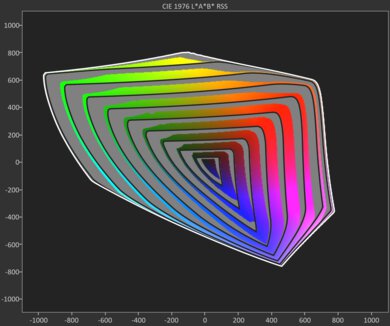 |
 |
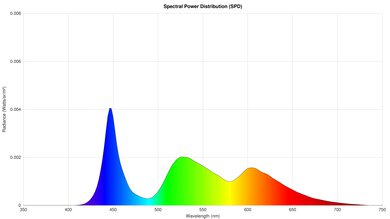 |
There's really no contest here, as QLEDs were primarily designed for one thing: better colors. One tool we can use to determine the range of colors a TV can produce is the spectral power distribution. By measuring pure white on a TV, we can see the intensity of light the TV outputs across the visible spectrum. If you look at the SPD of the two TVs above, you can see the much finer separation between the primary colors on the QN90F. There's less noise, which means that when the TV is trying to display a highly saturated red, for example, you're actually seeing red; it's not blended with other colors, so reds are red, not orange.
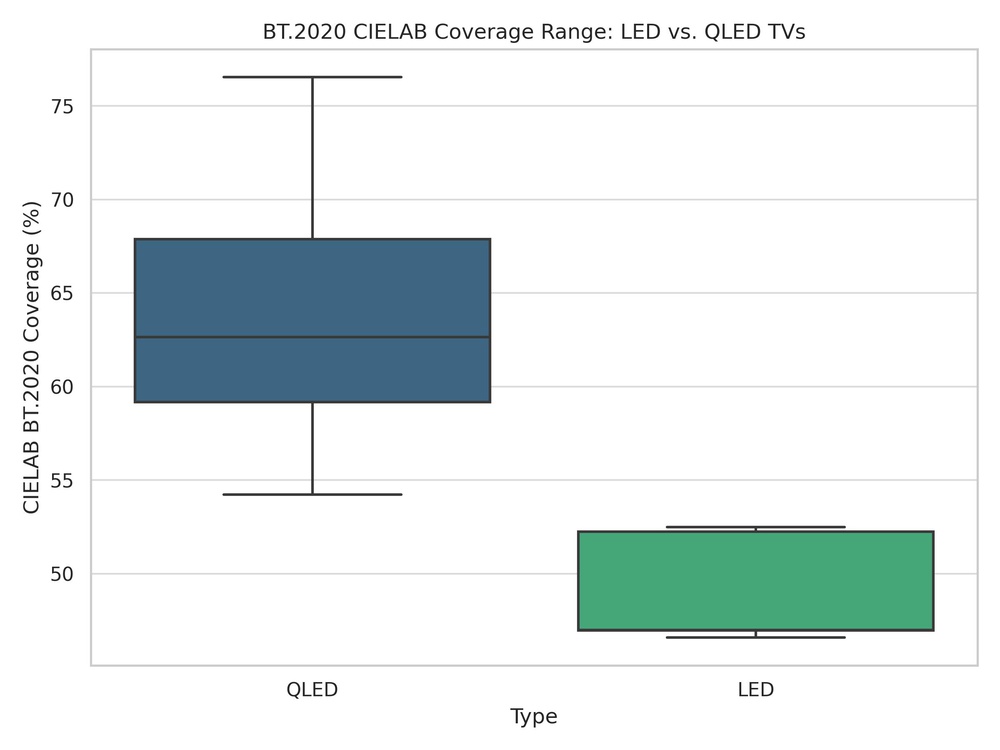
If we take a step back and look at the wider market, the difference is even more noticeable. The best LED TV on the market falls slightly short of the worst QLED, but on average, LEDs trail significantly behind QLEDs. While LEDs are still fine for most SDR content, which only targets the much smaller BT.709 color space, if you want to watch HDR, QLED is definitely the best choice. Unlike most of the other comparisons in this article, this is absolutely due to the technical differences between these two TV panel types; no LED TV could ever produce the same saturated colors that a QLED can.
Winner: QLED.
Uniformity
QLEDs tend to have better uniformity than LED TVs, but there's no real technical reason for this. Uniformity varies between individual units regardless of the panel tech used, so at the end of the day, it depends on manufacturing tolerances and the quality of the panel they're using. Since QLEDs tend to be higher-end models, they're better-sourced, using higher-quality panels and with more QC checks to avoid bad units. A few black sheep still get through, though, so at the end of the day, it's mostly just luck, but you have better chances with QLEDs.
Winner: QLED.
Response Time

From a purely technical standpoint, QLED or LED shouldn't impact the response time of the panel in any way. After all, the response time is mostly a factor of the TFT component of the LCD layer and how quickly it can adjust each individual pixel. There's still a difference between them, and QLEDs tend to be faster than most LEDs. If we take it one step further and separate QLEDs that use a KSF phosphor from the "true" QLED panels, the difference is even more significant. With this comparison, you can see that even the slowest QLED is faster than the fastest LED.
Except for KSF, which can have a slower decay time than other panel technologies, there's no real technical explanation for these differences. It largely comes down to market conditions. Since most LED TVs on the market are low-end models, it's expected that the far more expensive QLEDs perform better.
Winner: QLED.
Longevity
 |
 |
Both QLEDs and LED TVs have their share of issues, but buying a QLED is usually a safer bet for multiple reasons. Our own extensive testing has shown that thin edge-lit LCDs break faster, and while there are some edge-lit QLEDs out there, most edge-lit TVs are simple entry-level LEDs. If you're going with an LED, make sure it's direct-lit instead, meaning the LEDs are directly behind the screen instead of along one or more edges. While direct-lit TVs can and do fail, our accelerated longevity test has shown that most people won't have to worry about it, as they're unlikely to fail for many years.
QLEDs aren't immune to issues, though. The backlights that fail on LED TVs can also fail on QLEDs, since they're the same technology. The QLED layer itself can also degrade and fail over time, as shown with the Samsung QN95B above. This type of failure is rare, though, and typically starts to show up after 10,000 hours of use or more, and most of us will never keep a TV long enough for that to be an issue.
Winner: QLED.
Cost & Selection
The market is moving away from pure LED TVs, so selection is very limited. If you really want to limit yourself to an LED TV, you'll be looking at entry-level models with few features and poor picture quality overall. QLEDs, on the other hand, come in all shapes and sizes, from cheaper entry-level models up to the latest and greatest 4k and 8k models. It's not always obvious which brands actually use QLED panels, but basically anything that advertises a wider color gamut uses some form of quantum dot or KSF phosphor.
Winner: QLED.
Conclusion
If you didn't notice, QLEDs won every single category, so it should be pretty obvious now that the newer technology is far superior. Outside of a handful of cheap models from budget brands, LED TVs without quantum dots are a dying breed and should be avoided. Whether it's from the pure technical differences between them or external market forces, QLEDs are better in pretty much every way. If you're ready to start shopping for specific models to meet your needs and budget, check out our list of the best QLED TVs.



